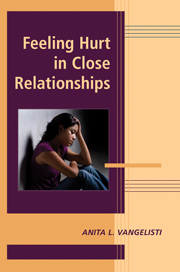Book contents
- Frontmatter
- Contents
- List of Contributors
- Foreword
- PART I INTRODUCTION
- PART II CONCEPTUALIZING HURT
- PART III HURTFUL ACTS
- 7 Rejection: Resolving the Paradox of Emotional Numbness after Exclusion
- 8 Conflict and Hurt in Close Relationships
- 9 When the Truth Hurts: Deception in the Name of Kindness
- 10 Affairs and Infidelity
- 11 Aggression, Violence, and Hurt in Close Relationships
- PART IV HURT IN RELATIONAL CONTEXTS
- PART V HURT IN APPLIED CONTEXTS
- Author Index
- Subject Index
- References
11 - Aggression, Violence, and Hurt in Close Relationships
from PART III - HURTFUL ACTS
Published online by Cambridge University Press: 04 August 2010
- Frontmatter
- Contents
- List of Contributors
- Foreword
- PART I INTRODUCTION
- PART II CONCEPTUALIZING HURT
- PART III HURTFUL ACTS
- 7 Rejection: Resolving the Paradox of Emotional Numbness after Exclusion
- 8 Conflict and Hurt in Close Relationships
- 9 When the Truth Hurts: Deception in the Name of Kindness
- 10 Affairs and Infidelity
- 11 Aggression, Violence, and Hurt in Close Relationships
- PART IV HURT IN RELATIONAL CONTEXTS
- PART V HURT IN APPLIED CONTEXTS
- Author Index
- Subject Index
- References
Summary
The fact that both physical and symbolic experiences are capable of instigating hurt is seldom more evident than in the context of intimate violence and aggression. Love and intimacy are not supposed to give way to aggression, and their peculiar union seems particularly poignant and potent. This chapter examines the topography of intimate partner aggression and its relationship to hurt and related phenomena.
Any and all attempts to chart a theoretical map of intimate violence are intrinsically selective in their attention to the existing literature. For example, it is relatively easy to find studies of the relationship between the experience of intimate violence and depression or anxiety but difficult to amass many studies of the attribution of who initiated physical aggression or the conditions under which violent couples emerge emotionally unscathed, or emotionally stronger, as a result of their aggressions. Consequently, the equation of violence and hurt often tends to be presumed rather than directly evidenced. Moreover, there is relatively little research on the possibilities that the hurtfulness of violence often may be (a) short lived and transient, (b) counterbalanced by co-occurring beneficial feelings or cognitions, or (c) an important phenomenological springboard to other more positive experiences.
To establish any claims regarding aggression and violence in close relationships, the cognate family of terms requires clarification. This is no mean task, as almost any attempt at definition risks “violence” against some ideological or intellectual altar. This is one of many conceptual hazards necessary to traverse.
- Type
- Chapter
- Information
- Feeling Hurt in Close Relationships , pp. 209 - 232Publisher: Cambridge University PressPrint publication year: 2009
References
- 3
- Cited by



